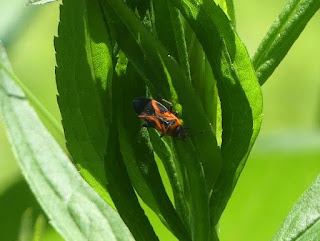False Milkweed Bug
Here's a False Milkweed Bug I met a couple months back.
These guys have aposematic coloring but in their case it's misleading. As insects without a strong physical defense and that's not poisonous, they are advertising that they're dangerous to eat even though they're not. What they do have going for them is they look like (and are actually related to) the poisonous Large Milkweed Bug (a very common bug around me) and the Small Milkweed Bug (which is less common but looks even more similar to the False Milkweed Bug). This is called Batesian mimicry, basically impersonation a dangerous species when you're not dangerous.
I don't think False Milkweed Bugs have been studied enough to know why they look the way they do. Did they evolve their red coloring so they'd look like their poisonous cousins? Or did their ancestors eat milkweed, develop their red coloring, and then evolve to eat a non-milkweed diet? Interestingly the Large Milkweed Bug eats exclusively milkweed, the Small Milkweed Bug eats both milkweed and other plants, and the False Milkweed Bug never eats milkweed. Perhaps the Small Milkweed Bug is in the process of weaning itself off of milkweed, and in a million years or so they'll have a diet like the False Milkweed Bug? Stay tuned!
 |
| June 5, 2021 at Duke Farms Photo 136368194, (c) jpviolette, some rights reserved (CC BY-NC) |



Comments
Post a Comment